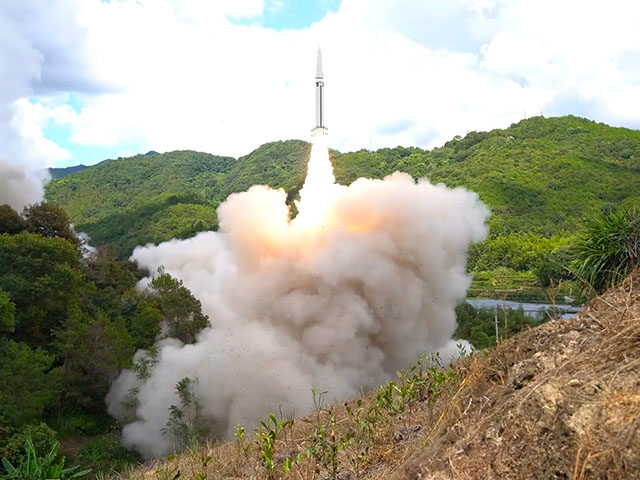The Stockholm International Peace Research Institute (SIPRI), an arms control group partly funded by the Swedish government, published a report on Monday that found China’s nuclear arsenal is growing faster than any other nation on Earth.
SIPRI’s annual report monitors the stockpiles of nine nuclear-armed states: the U.S., Russia, UK, France, China, India, Pakistan, North Korea, and Israel. The 2024 edition said all of these states “continued to modernize their nuclear arsenals and several deployed new nuclear-armed or nuclear-capable weapon systems in 2023.”
China’s development was particularly troubling because not only has it dramatically increased the size of its nuclear inventory but, in 2023, it placed some of its warheads on “high operational alert” for the first time.
Russia and the United States still control nearly 90 percent of the world’s nuclear weapons, with China now in third place, although the UK and France are believed to have more nuclear weapons currently “deployed” than China. China’s inventory reportedly jumped from 410 warheads to 500 over the past year.
“Depending on how it decides to structure its forces, China could potentially have at least as many intercontinental ballistic missiles (ICBMs) as either Russia or the USA by the turn of the decade, although its stockpile of nuclear warheads is still expected to remain much smaller than the stockpiles of either of those two countries,” the report cautioned.
The size of the U.S. and Russian inventories was relatively stable during 2023, although SIPRI noted Russia “deployed around 36 more warheads with operational forces” than the previous year because of the war in Ukraine.
This number does not include the warheads Russia allegedly moved into Belarus, because SIPRI found “no conclusive visual evidence that the actual deployment of warheads has taken place.”
The authors of the report noted that both the U.S. and Russia have grown more secretive about their nuclear arsenals since Russia invaded Ukraine and precipitated a global security crisis, while China is always secretive about everything.
Among the less heavily armed nuclear powers, the UK has announced plans to increase its stockpile from 225 to 260 warheads, while France is working on a new generation of ballistic missile submarine, and India is developing longer-range nuclear missiles – possibly because it increasingly views China as more of a threat than its nuclear-armed neighbor and rival, Pakistan.
Then there is North Korea, the most immediately alarming of the world’s nuclear powers, a Communist tyranny even more secretive and belligerent than its patrons in Beijing. SIPRI believes North Korea now has about 50 operational warheads, 20 more than it had last year.
Pyongyang managed to get through 2023 without any nuclear test detonations but it conducted several test-launches to improve its short-range ballistic missiles and it appears to have developed at least one short-range nuclear-capable missile that can be launched from a silo.
This troubled the report’s authors because it suggests North Korea is shifting toward a “tactical nuclear” strategy, meaning smaller-yield weapons launched at shorter ranges to control a battlefield.
“There is a growing concern that North Korea might intend to use these weapons very early in a conflict,” said SIPRI researcher Matt Korda.
The report noted that Israel does not publicly acknowledge its small nuclear arsenal or divulge information about weapons development, but it is “believed to be modernizing its nuclear arsenal and appears to be upgrading its plutonium production reactor site at Dimona.”
SIPRI was pessimistic about the effects of the Ukraine and Gaza war on disarmament efforts. Russia has grown deeply antagonistic toward the U.S. and NATO powers, withdrawing from several significant arms-control treaties since the Ukraine conflict began. Russia and its dictatorial President Vladimir Putin regularly threaten to use tactical nuclear weapons if NATO intervenes in the Ukraine invasion, or if Ukraine makes too much progress in repelling Russia forces.
“We have not seen nuclear weapons playing such a prominent role in international relations since the Cold War. It is hard to believe that barely two years have passed since the leaders of the five largest nuclear-armed states jointly reaffirmed that ‘a nuclear war cannot be won and must never be fought,’” SIPRI Weapons of Mass Destruction Program director Wilfred Wan mournfully observed.
The Gaza conflict and Tehran’s sponsorship of terrorist proxy attacks against Israeli and Western targets has clearly made non-proliferation more difficult when it comes to Iran.
The only bright spot in SIPRI’s summary of nuclear diplomacy was Secretary of State Antony Blinken touting “increased space for dialogue” between the U.S. and China, although that bit of optimism would seem to be undercut by China cranking out nuclear weapons as fast as it can, and growing increasingly comfortable with maintaining some its arsenal on “operational alert” status instead of keeping all of its weapons in storage.
“While the global total of nuclear warheads continues to fall as cold war-era weapons are gradually dismantled, regrettably we continue to see year-on-year increases in the number of operational nuclear warheads. This trend seems likely to continue and probably accelerate in the coming years and is extremely concerning,” concluded SIPRI Director Dan Smith.

COMMENTS
Please let us know if you're having issues with commenting.